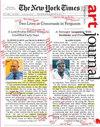透过断头台的镜子:克劳德·卡洪的反虚无的转换理论
IF 0.3
3区 艺术学
0 ART
引用次数: 0
摘要
摘要在20世纪90年代,艺术历史学家将克劳德·卡洪和马塞尔·摩尔确立为女同性恋超现实主义者,他们的性别越界照片作品预示着女权主义对性别表演的探索。与此同时,Cahun和Moore的作品也在Timtum:A Trans Jew Zine地下流传,活动艺术家Micah Bazant在那里庆祝Cahun是一位反法西斯跨性别艺术家,他生活在一个尚未命名的性别化身中。本文将这段研究不足的历史视为跨时间的“接触”,通过这种接触,卡洪和摩尔的作品影响了政治化的跨性别非二元身份的形成,并在他们自己的历史背景和我们的历史背景下考虑了卡洪的性别不一致性。我认为,Cahun和Moore不仅过着跨性别的生活,而且他们的艺术作品明确反对他们那个时代的医学和心理学话语,这些话语试图在跨性别和双性人的身心中找到二元性别的“真相”。为了指出身体指数性的极限,他们在摄影指数性的限制下,将跨化身理论化为对时间生物政治可读性的逃避。这些结论为当代展览提供了新的视角,在这些展览中,卡洪和摩尔的作品代表了自由民族国家保护的性别自由。本文章由计算机程序翻译,如有差异,请以英文原文为准。
Through the Guillotine Mirror: Claude Cahun’s Theory of Trans against the Void
Abstract During the 1990s art historians established Claude Cahun and Marcel Moore as lesbian Surrealists whose oeuvre of gender-transgressing photomontages anticipated feminist explorations of gender performativity. Meanwhile Cahun and Moore’s artworks also circulated underground in Timtum: A Trans Jew Zine, where activist artist Micah Bazant celebrated Cahun as an anti-fascist trans artist who lived a gendered embodiment as yet unnamed. Investigating this understudied history as cross-temporal “touch” whereby Cahun and Moore’s work influenced the shape of politicized trans nonbinary identities, this essay considers Cahun’s gender nonconformity both within their own historical context and within ours. I argue that not only did Cahun and Moore live trans lives, but that their artwork explicitly opposed the medical and psychological discourses of their era which sought to find the “truth” of binary gender inside the bodies and minds of trans and intersex subjects. Working at the limits of photographic indexicality in order to point to the limits of the body’s indexicality, they theorized trans embodiment as an evasion of chronobiopolitical legibility. These conclusions shed new light on contemporary exhibitions in which Cahun and Moore’s work stands for the gender freedoms protected by the liberal nation state.
求助全文
通过发布文献求助,成功后即可免费获取论文全文。
去求助

 求助内容:
求助内容: 应助结果提醒方式:
应助结果提醒方式:


